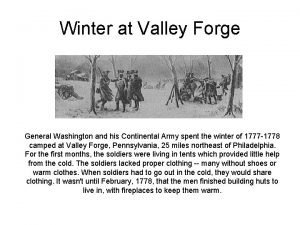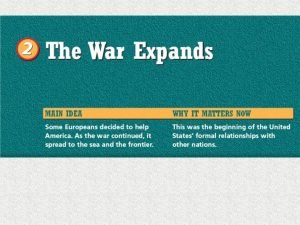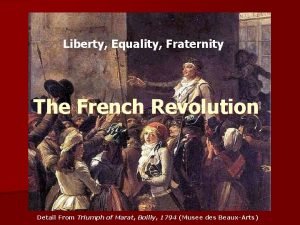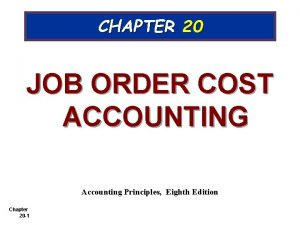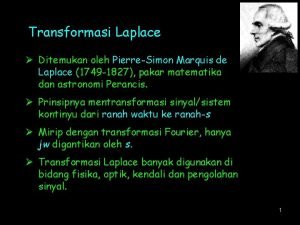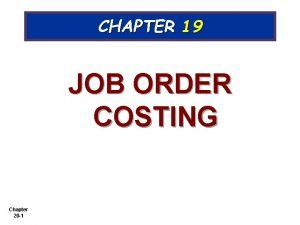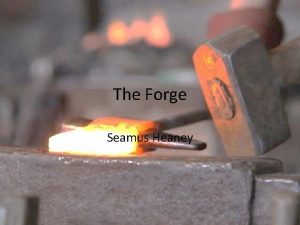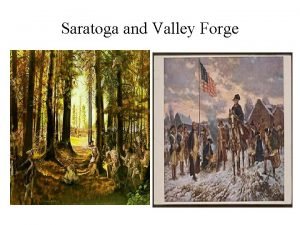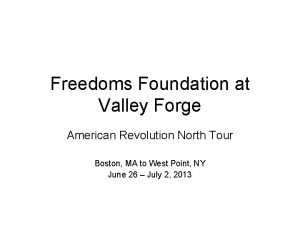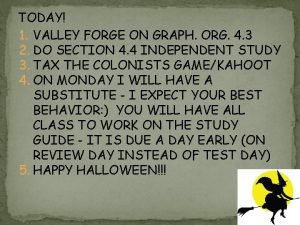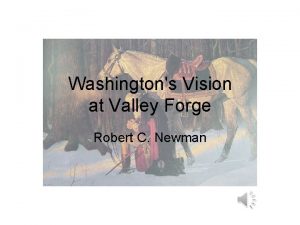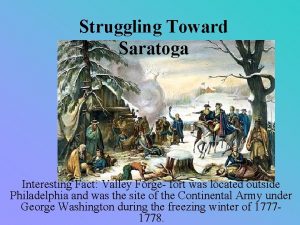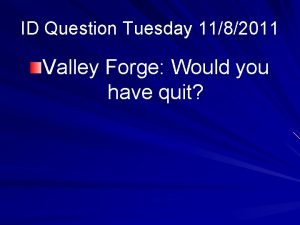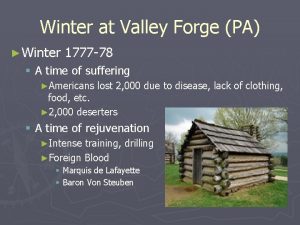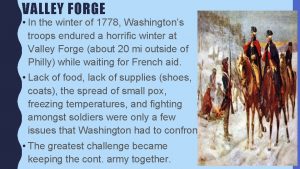Valley Forge Here are Washington and the Marquis






















- Slides: 22

Valley Forge Here are Washington and the Marquis De Lafayette at the frigid-cold army Headquarters at Valley Forge, Pennsylvania

Valley Forge Dear Sir, It is with great reluctance, I trouble you on a subject, which does not properly fall within your province; but it is a subject that occasions me more distress, than I have felt, since the commencement of the war; and which loudly demands the most zealous exertions of every person of weight and authority, who is interested in the success of our affairs 1—I mean the present dreadful situation of the army for want of provisions and the miserable prospects before us, with respect to futurity. It is more alarming, than you will probably conceive, for to form a just idea, it were necessary to be on the spot. 2 For some days past, there has been little less, than a famine in camp. A part of the army has been a week, without any kind of flesh & the rest three or four days. 3 Naked and starving as they are, we cannot eno�ugh�admire the incomparable patience and fidelity of the soldiery, that they have not been, ere this, excited by their sufferings, to a general mutiny and dispersion. Strong symptoms however of discontent have appeared in particular instances; and nothing but the most active effort�s�every where, can long avert so shocking a catastrophe

Daughters Of Liberty Daughters of Liberty

A “Daughter of Liberty” Women served in many capacities during the Revolutionary War, and some even took up arms and helped to fight. One of these “daughters of liberty” was Hannah Snell, depicted on this woodcut. Another-Anna Marie Lane-actually received a soldier’s pension from the Virginia Assembly at the close of the Revolution.


Join, or Die' is a well-known political cartoon, created by Benjamin Franklin and first published in his Pennsylvania Gazette on May 9, 1754. [1] The original publication by the Gazette is the earliest known pictorial representation of colonial union produced by a British colonist in America. [2] It is a woodcut showing a snake severed into eighths, with each segment labeled with the initials of a British American colony or region. New England was represented as one segment, rather than the four colonies it was at that time. In addition, Delaware and Georgia were omitted completely. Thus, it has 8 segments of snake rather than the traditional 13 colonies. [3] The cartoon appeared along with Franklin's editorial about the "disunited state" of the colonies, and helped make his point about the importance of colonial unity. During that era, there was a superstition that a snake which had been cut into pieces would come back to life if the pieces were put together before sunset The cartoon became a symbol of colonial freedom during the American Revolutionary War.

A Soldier at Valley Forge Here is one of the shoeless, poorly-clothed American soldiers at Valley Forge. In April, 1778 George Washington wrote to a congressman: “to see men without clothes … without blankets … without shoes … their marches … traced by the blood from their feet … and submitting to it without a murmur, is a mark of patience and obedience which in my opinion can scarce be paralleled. ”

A Soldier at Valley Forge

Recruitment posters encourage “gentlemen” that were brave to fight for liberty and against the slavery of Britain.

WWW. alamy. com – BTJK 7 C

Sent Here to Starve and Freeze

Dr. Albigence Waldo • December 14, 1777—Prisoners & Deserters are continually coming in. The Army which has been surprisingly healthy hitherto, now begins to grow sickly from the continued fatigues they have suffered this Campaign. Yet they still show a spirit of Alacrity & Contentment not to be expected from so young Troops. I am Sick— discontented—and out of humour. Poor food—hard lodging—Cold Weather— fatigue—Nasty Cloaths—nasty Cookery—Vomit half my time—smoak’d out of my senses—the Devil’s in’t—I can’t Endure it—Why are we sent here to starve and Freeze—What sweet Felicities have I left at home; A charming Wife—pretty Children—Good Beds—good food—good Cookery— all agreeable—all harmonious. Here all Confusion—smoke & cold — hunger & filthyness—A pox on my bad luck. There comes a bowl of beef soup—full of burnt leaves and dirt, sickish enough to make a Hector spue—away with it Boys—I’ll live like the Chameleon upon Air. Poh! Crys Patience within me—you talk like a fool. Your being sick Covers your mind with a Melanchollic Gloom, which makes everything about you appear gloomy. See the poor Soldier, when in health—with what cheerfulness he meets his foes and encounters every hardship—if barefoot, he labours thro’ the Mud & Cold with a Song in his mouth extolling War & Washington—if his food be bad, he eats it notwithstanding with seeming content—blesses God for a good Stomach and Whistles it into digestion.

Revolutionary Soldiers

Revolutionary War Soldiers It was commonly believed by soldiers of the British army that the colonial militia consisted of low-quality soldiers who came from the dregs of society. They believed that the militia would not have the strength or organization to match the British War Machine. They were mistaken. In fact, the soldiers of the colonial militia included doctors, teachers, and young boys who contributed greatly to the war effort. Often, the ranks of the colonial militia were filled by average citizens. Soldiers of the Revolutionary War came from all walks of life and different ethic groups. Some were native-born colonists, some British immigrants, and some were freed black slaves. A majority of the men were Scotch-Irish, as seen in the Pennsylvania regiments. The average soldier of the militia served alongside Rangers, Highlanders, Iroquois Indians, and British regulars. Much of the British regular army was recruited from the lowest social classes. The enlisted were petty criminals, beggars, common laborers or subsistent farmers. Because the British officer’s own troops often consist of these types, they were more than willing to believe the same about the colonial soldiers. British officers showed contempt for both the colonial enlisted soldiers and colonial officers alike. While it was true that many of the militia came from the lower social classes, more than a few were from middle class families. A soldier’s social status and civilian occupation depended greatly upon where he was recruited. Soldiers who came from Pennsylvania were usually workers. The surviving muster rolls show that about sixty percent of the soldiers listed were laborers. The remaining forty percent were either artisans or skilled workers. The majority of the artisans from the Pennsylvania colony worked in cloth, wood, or leather trades. Most of the artisans were cloth workers, while the remainder came from cooper and carpentry trades. Evidence of this can be seen from the statistics for those soldiers recruited from the Philadelphia area. Soldiers were recruited from outside Philadelphia had a higher percentage of manual laborers in their ranks. Only about half the number of skilled trades seen in the city were present in the rural area. About twice as many skilled artisans came from the cities of colonial America. Soldiers who enlisted from other parts of the colonies had almost the exact opposite percentage of laborers versus artisans. Only twenty six percent of those soldiers who came from the colony of Massachusetts were listed as laborers before entering the militia. Approximately 52% of the Massachusetts soldiers were skilled artisans before enlisting, which was very different from those who enlisted from Pennsylvania. Many of the soldiers who fought for the colonies in the Revolutionary War came from well-to-do families. These were not men who saw the army as a career and they did not need to rely on their military income to survive.

Colonial Minute Men

A Colonial Minuteman In this picture, a minuteman prepares for war. Each citizen soldier was provided with a musket, a cartridge box, and thirty-six rounds of ammunition and was expected to be ready to fight within sixty seconds of being called.




Common Sense By Thomas Paine Introduction Perhaps the sentiments contained in the following pages, are not YET sufficiently fashionable to procure them general favour; a long habit of not thinking a thing WRONG, gives it a superficial appearance of being RIGHT, and raises at first a formidable outcry in defense of custom. But the tumult soon subsides. Time makes more converts than reason. As a long and violent abuse of power, is generally the Means of calling the right of it in question (and in Matters too which might never have been thought of, had not the Sufferers been aggravated into the inquiry) and as the King of England hath undertaken in his OWN RIGHT, to support the Parliament in what he calls THEIRS, and as the good people of this country are grievously oppressed by the combination, they have an undoubted privilege to inquire into the pretensions of both, and equally to reject the usurpation of either. In the following sheets, the author hath studiously avoided every thing which is personal among ourselves. Compliments as well as censure to individuals make no part thereof. The wise, and the worthy, need not the triumph of a pamphlet; and those whose sentiments are injudicious, or unfriendly, will cease of themselves unless too much pains are bestowed upon their conversion. The cause of America is in a great measure the cause of all mankind. Many circumstances hath, and will arise, which are not local, but universal, and through which the principles of all Lovers of Mankind are affected, and in the Event of which, their Affections are interested. The laying a Country desolate with Fire and Sword, declaring War against the natural rights of all Mankind, and extirpating the Defenders thereof from the Face of the Earth, is the Concern of every Man to whom Nature hath given the Power of feeling; of which Class, regardless of Party Censure, is the AUTHOR. Philadelphia, Feb. 1776


 Washington and lafayette inspect the troops at valley forge
Washington and lafayette inspect the troops at valley forge Antigentest åre
Antigentest åre Importance of valley forge
Importance of valley forge Melinda marquis
Melinda marquis Marquis de lafayette
Marquis de lafayette Marquis de ferral
Marquis de ferral Movies new hartford ny
Movies new hartford ny Tuileries
Tuileries Marquis test color
Marquis test color Marquis de mainvillette
Marquis de mainvillette Marquis reaktifi
Marquis reaktifi Don marquis why abortion is immoral
Don marquis why abortion is immoral Melinda marquis
Melinda marquis Marquis company estimates that annual manufacturing
Marquis company estimates that annual manufacturing Tabel invers laplace
Tabel invers laplace Marquis with two oval
Marquis with two oval Marquis company estimates that annual manufacturing
Marquis company estimates that annual manufacturing There's a place where streams of grace
There's a place where streams of grace Walnut tree forge poem
Walnut tree forge poem Let's go to barry island poem analysis
Let's go to barry island poem analysis In september john ormond poem
In september john ormond poem Type of poem
Type of poem Pine forge press
Pine forge press
